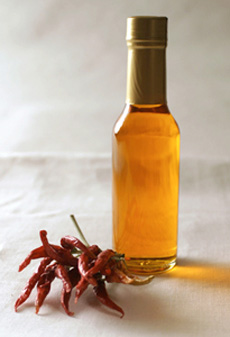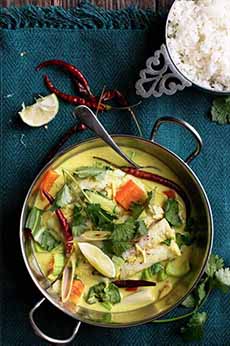Make Your Own Curry Powder & Chile Oil & The History Of Curry
|
|
Today’s tip is a teaching moment from Chef Johnny Gnall. If you have questions or suggestions for tips, email Chef Johnny. If you produce your own seasonings, you have the discretion to alter them to fit your preferences, whether they be increasing the heat, decreasing the garlic or making whatever changes suit you. Here are two Asian seasonings for you to make, store, and use: curry powder and chile oil. They’re easy to make, and you can use them in everything from breakfast eggs and luncheon salads to dinner recipes. You can give them as gifts, too: delicious ingredients with a personal touch. Make them in small batches at first, until you reach a level of comfort with the process. Once you have it down, you can make quarts or more at a time and have them in your pantry for use in specific recipes, or to experiment with—or that last-minute gift. This recipe is for a very basic curry powder. Curry powders you buy at the grocery store tend to be pretty generic (especially the domestic products made for the “American palate”), so you really are better off creating your own. It will save you money and enable you to bring out the flavors that you prefer. Throughout India and Asia, each household and restaurant has its proprietary recipe. > The chile oil recipe is below. Ingredients 1. It’s a good idea to toast your spices in a pan over medium-high heat, tossing as you do so; it will make your curry powder that much more aromatic and flavorful. 2. You can use a food processor or blender to combine the spices, or just mix them thoroughly with a wire whisk. Mix thoroughly and store in a tightly-capped jar or bottle. Variations Curry is both a spice blend and a variety of dishes in a sauce prepared with a blend of curry spices. Ingredients in both the spice blends and the dishes made with them vary widely. To make matters more complex, there is also the kari plant, the sweet, aromatic leaves of which are used in southern and southwestern Indian regional cooking. They can be added to curry dishes separately or in a curry powder. While blends varied by region and household, they usually included cumin, coriander, fresh or dried chilies, ginger, and turmeric. When not referring to a spice blend, curry generally describes dishes prepared in a sauce. In the West, curry has come to mean a dish (meat, seafood, vegetable) in a sauce or gravy seasoned with a complex mixture of ground spices, with different levels of heat. And it still refers to the curry powder itself. Some sources say the word derives from the Tamil kari, meaning black pepper according to some historians. Other historians say it refers to a lightly spiced sauce. In contemporary Tamil Nadu, kari, in many contexts refers to meat. Here’s more about it. The Curry Spice Blend The foundation of many Indian curry dishes is a mixture of onion, ginger, and garlic flavored with several spices or a blend. The blend typically includes a selection of cardamom, cinnamon, cloves, coriander, cumin, fennel seed, fenugreek, mustard seed, black and red (cayenne) pepper, and turmeric (which imparts the characteristic yellow of the more familiar [to Americans] curry powder), all toasted and finely ground. Other ingredients may include curry leaves (Murraya koenigii), chilies, nutmeg, mace, poppy seed, star anise, and bay leaves. Each region of the country has its own flavor profile, and each cook has his/her own preferred blend. |
|
|
But back to the past: Archaeological evidence from modern-day Pakistan (which borders modern-day India), dating to 2600 B.C.E., suggests a mortar and pestle were used to grind spices including mustard, fennel, cumin, and tamarind pods. Another spice often included in curry powder, black pepper is native to the Indian subcontinent and Southeast Asia and has been known to Indian cooking since at least 2000 B.C.E. [source]. Evidence for a blend of spices that came to indicate a complex mixture of spices and herbs, including the aforementioned spices joined by garlic, ginger, and turmeric (later known as kari), dates to 2500 B.C.E. As people migrated and brought their recipes with them, many varieties of curry evolved. The next significant influence was the establishment of the Portuguese trading center in Goa in 1510. Kari was transcribed as “curry” by Portuguese traders. |
||
|
RECIPE #2: MAKE YOUR OWN CHILE OIL This recipe is for a fermented chile oil—much more complex than a store-bought chile oil. Says Chef Johnny: “I absolutely love oils like this. The fermentation develops the flavor in a unique way and brings out umami, which makes a recipe that much better. “Drizzle it into soups for a garnish-with-a-kick; add some to salad dressings, sauces, and marinades; use as a dipping oil; finish a sauté. It can be substituted wherever oil is used as a condiment, alone or in combination with a mild oil.” Ingredients |
 Homemade chile oil (photo © Caviar Russe | New York City). |
|
|
Preparation 1. Combine the flavor ingredients in the oil and heat over medium-low heat, to about 150°F (use a kitchen thermometer). 2. Remove from the heat and allow to cool to room temperature. Once cool, transfer to a jar or other lidded container and cap tightly. 3. Let the mixture sit for at least a week, preferably two weeks; then it’s ready to go. It’s interesting to see how the flavors develop and change as the fermentation process takes place. 4. Once you’ve made a successful (to your preference) batch, you can try versions with other herbs and aromatics. For gifts, tie a ribbon around the neck of a bottle and use your computer printer to create a gift label. *The Columbian Exchange, also known as the Columbian Interchange, was the widespread transfer of animals, plants, precious metals, commodities, culture, human populations, technology—and yes, diseases—between the New World (the Americas) in the Western Hemisphere, and the Old World (Afro-Eurasia) in the Eastern Hemisphere, in the late 15th and following centuries. CHECK OUT WHAT’S HAPPENING ON OUR HOME PAGE, THENIBBLE.COM. |
||







